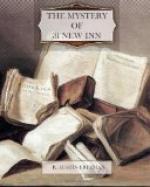He drew from his pocket a “combination” knife containing, among other implements, a screw-driver, with which he carefully extracted the screws from one of the little brass plates by which the frame had been suspended from the nails.
“You see,” he said, when he had removed the plate and carried the photograph over to the gasjet, “the wood covered by the plate is as dirty and time-stained as the rest of the frame. The plates have been put on recently.”
“And what are we to infer from that?”
“Well, since there are no other marks of plates or rings upon the frame, we may safely infer that the photograph was never hung up until it came to these rooms.”
“Yes, I suppose we may. But what then? What inference does that lead to?”
Thorndyke reflected for a few moments and I continued:
“It is evident that this photograph suggests more to you than it does to me. I should like to hear your exposition of its bearing on the case, if it has any.”
“Whether or no it has any real bearing on the case,” Thorndyke answered, “it is impossible for me to say at this stage. I told you that I had proposed to myself one or two hypotheses to account for and explain Jeffrey Blackmore’s will, and I may say that the curious misplacement of this photograph fits more than one of them. I won’t say more than that, because I think it would be profitable to you to work at this case independently. You have all the facts that I have and you shall have a copy of my notes of Marchmont’s statement of the case. With this material you ought to be able to reach some conclusion. Of course neither of us may be able to make anything of the case—it doesn’t look very hopeful at present—but whatever happens, we can compare notes after the event and you will be the richer by so much experience of actual investigation. But I will start you off with one hint, which is this: that neither you nor Marchmont seem to appreciate in the least the very extraordinary nature of the facts that he communicated to us.”
“I thought Marchmont seemed pretty much alive to the fact that it was a very queer will.”
“So he did,” agreed Thorndyke. “But that is not quite what I mean. The whole set of circumstances, taken together and in relation to one another, impressed me as most remarkable; and that is why I am giving so much attention to what looks at first sight like such a very unpromising case. Copy out my notes, Jervis, and examine the facts critically. I think you will see what I mean. And now let us proceed.”
He replaced the brass plate and having reinserted the screws, hung up the frame, and proceeded to browse slowly round the room, stopping now and again to inspect the Japanese colour-prints and framed photographs of buildings and other objects of archaeological interest that formed the only attempts at wall-decoration. To one of the former he drew my attention.
“These things are of some value,” he remarked. “Here is one by Utamaro—that little circle with the mark over it is his signature—and you notice that the paper is becoming spotted in places with mildew. The fact is worth noting in more than one connection.”




